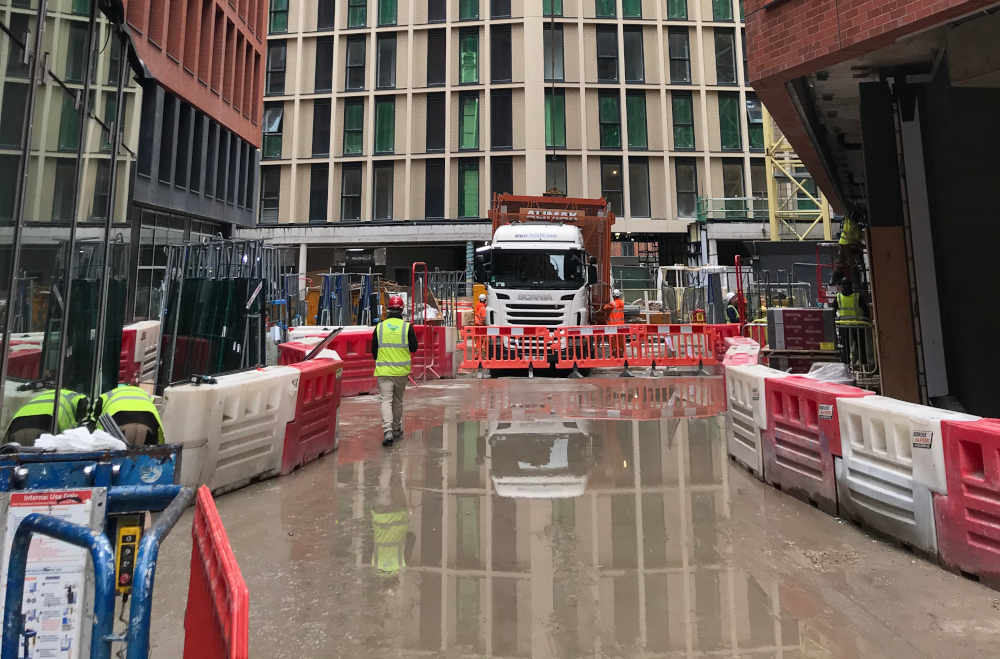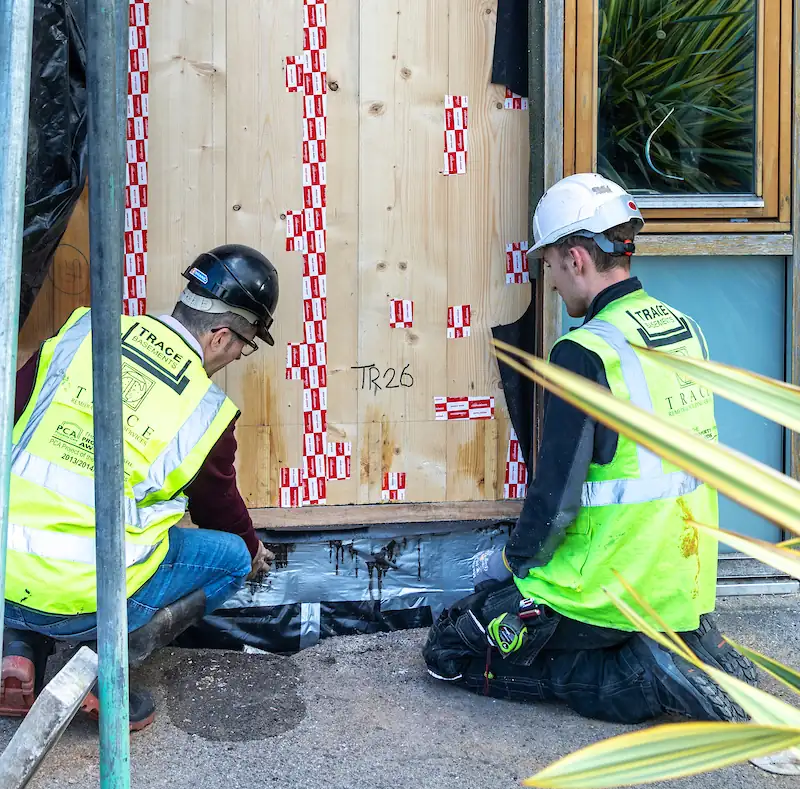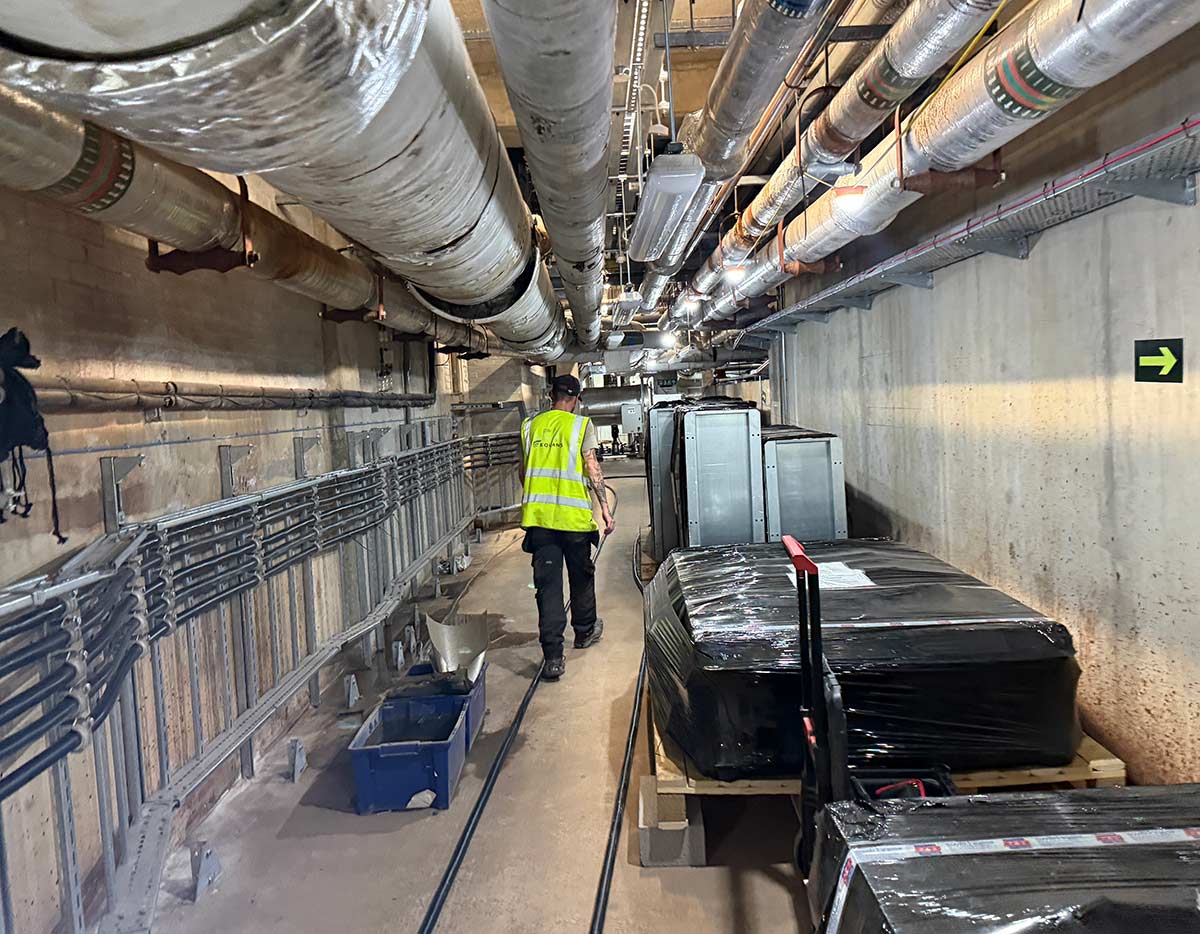Deck & Flat Roof Waterproofing Contractor
Get in touch

Trace Basements are specialist deck waterproofing contractors.
'Podium decks, buried roofs, green roofs, blue roofs, flat roofs with continuously supported coverings' – these are the terms used to describe waterproofing systems which are ‘flat’ or rather laid to minimal falls, typically including some form of build-up over (paving for example), which conceals the waterproofing.
These structures can be common above basements, where basements extend out beyond the exterior walls of the building above ground.
Podium Deck, Buried Roof & Flat Roof Waterproofing
Partnership with AXTER
The design and installation of systems which protect against rainwater ingress from above, is its own specialist field, with specific differences when compared to waterproofing for below ground structures. It is closer to roofing, than it is to basement waterproofing.
Trace are pleased to partner with AXTER, a flat roofing specialist manufacturer, providing design, quality assurance, guarantee, insurance and training support, alongside our own design and installation expertise.
Trace Basements, as an approved Axtershield installer, are trained and certified to install two Axter material systems, providing flexibility across differing project scenarios.


Starcoat PMMA four layer deck waterproofing installed by Trace
Specialist Expertise
Our team possesses specific knowledge in deck waterproofing systems, understanding the unique challenges of protecting structures from above-ground water ingress
Manufacturer Partnership
Direct collaboration with AXTER ensures access to premium materials, extended warranties, and ongoing technical support throughout the project lifecycle
Long-term Performance
We prioritise durable solutions with extended material warranties, eliminating concerns about system failure beyond standard warranty periods.
Comprehensive Protection for Deck Structures
Axter Starcoat PMMA
PMMA (polymethyl methacrylate) represents a cold-applied, four-layer reinforced liquid waterproofing system. This flexible solution proves particularly effective for smaller areas, complex detailing work, and applications requiring UV-stable materials. The system is available with manufacturer warranties of up to 25 years.
Axter Wilotekt Plus
Axter Wilotekt is a second-generation hot melt waterproofing system engineered for larger applications and installation beneath various build-up configurations, including green roof systems. The primary advantage of Wilotekt lies in its exceptional durability and longevity, backed by manufacturer warranties of up to 35 years and a life-of-structure expectancy of 60 years. For buried and inaccessible waterproofing applications, material longevity becomes paramount. Clients require confidence that their investment will perform throughout the building's operational life, particularly when access for maintenance or replacement is severely limited. Wilotekt provides this assurance where many alternative materials offer only ten-year warranty periods.
System Design - Falls and drainage are important aspects of deck waterproofing
Decks will always receive rainfall and management of that water is a key consideration. What you do not want is for water to collect, stand and pressure - it is hydrostatic pressure which forces water through any defects/pathways where present, and long term standing water can be detrimental to some forms of materials.
Systems must be designed in accordance with BS6229 (2018) which advises falls of 1:80 towards maintainable drainage outlets. Some materials/systems (including both the Starcoat PMMA and Wilotekt systems we employ), can be employed on a 'zero falls' deck.
Zero falls may sound like a 'flat' deck, i.e. without any falls, but in practice it means decks with falls between zero and 1:80. Backfalls and ponding are to be avoided.
Being able to design for 'zero falls' is a benefit, particularly on remedial schemes where there is often limited scope in which to alter finished levels. Trace have sucessfully implemented systems down to 1:30 falls using Axter Starcoat PMMA.
Quality assurance for deck waterproofing systems
Trace employ forms of deck waterproofing which can be tested via what is know as spark or holiday testing. An electrical current is passed over the membrane via specialist equipment which identifies if there is any loss or conduction of the current through the waterproof material, i.e. is there a hole or thin section weak point, representing a risk to the system.
In addition, Axter employ dedicated QA staff whose role is to attend, inspect and report upon the quality of installations for ultimate client confidence in the installed measures. Axter QA is a requirement to achieve Axter guarantees.
The Axter guarantee scheme
With our decades of experience in structural waterproofing, we did initially question the value of a manufacturer guarantee scheme, because in practice (at least in basement waterproofing), these are worth very little, because where issues occur, it is more often that not associated with poor design or poor installation, and suppliers/manufacturers tend to blame this (often rightly so) to avoid costs. Best case they may provide some replacement materials, and in reality it is for the designer/installer to address any issues with installed systems.
Axter provide differing levels of guarantees, but at the higher end, their 'platinum level', they cover materials, design and workmanship for up to 35 years (system dependent), with an insurance backed guarantee through QANW insurance. It is a covered by a true insurance policy and subject to IPT (insurance premium tax) which is the test of whether a policy is true insurance, or not.
It is the processes, rather than marketing lip-service that have impressed us, in that materials ordered are tracked against every project using them, meaning that there is a record held by Axter of what is installed where, and then the level of quality assurance that is applied by their dedicated inspectors, creates a record of installation, ensuring that it has been installed correctly, and that any issue or limitation arising gets addressed. It is more than just a guarantee scheme.
We aren't adapting basement waterproofing materials designed for stiff reinforced concrete retaining structures, for suspended and flexible deck structures formed in different materials like pre-tensioned and pre-cast concrete. We aren't working with neophyte levels of support, our systems, designs and supplier support are proven and eminently fit for purpose. If you have a deck requirement, we would be glad to assist.

Starcoat PMMA four layer system - primer coat, two coats of PMMA with fleece reinforcement finished with sealer coat.
Experts in Structural Waterproofing & Timber Repair
Trace are Industry leading waterproofing contractors
Get in touch
Winning awards & Accreditations
.webp)


.webp)

Experts in Structural Timber Repair for Listed Buildings
Complex buildings need the highest level of expertise. We specialise in dealing with complex issues of moisture in buildings, including basement waterproofing, waterproofing maintenance, timber repair for new and old buildings.
Find out more














.avif)







.avif)
